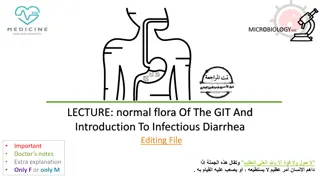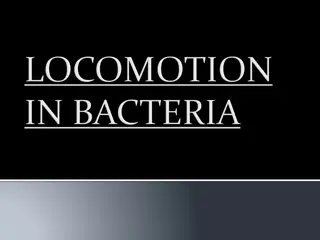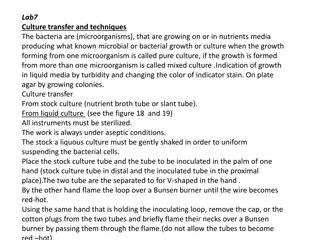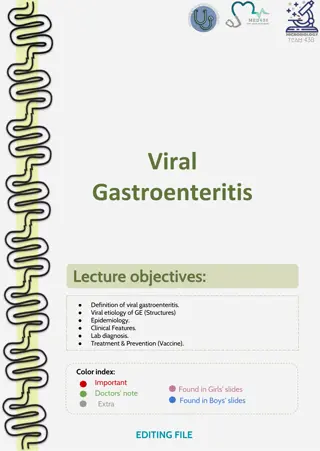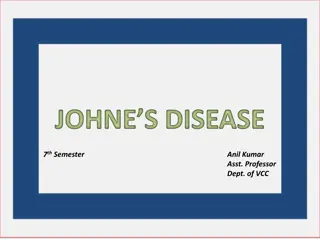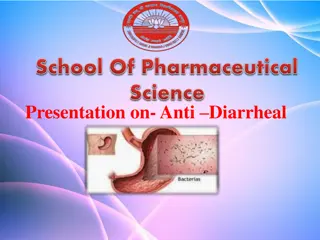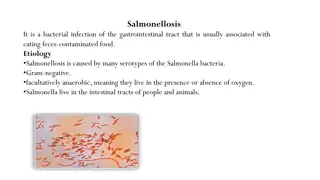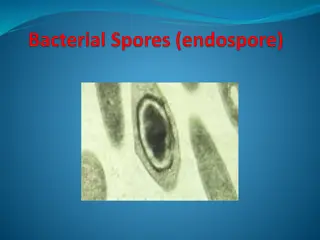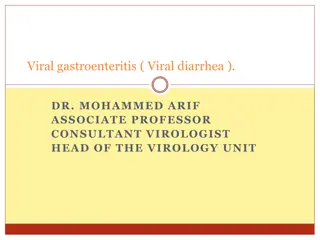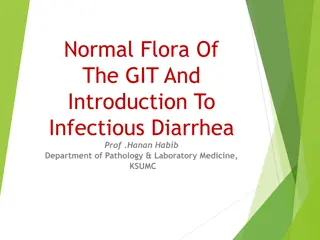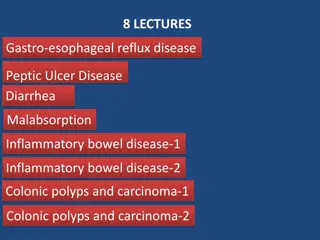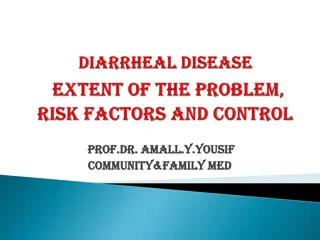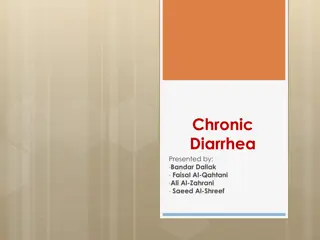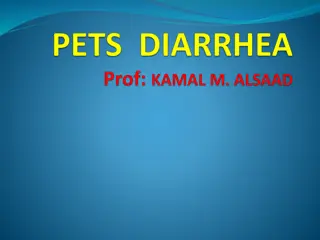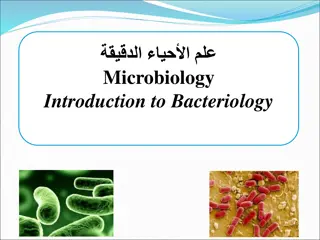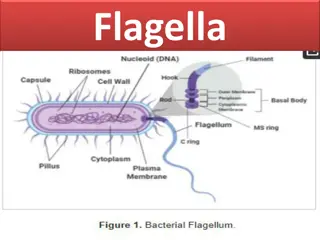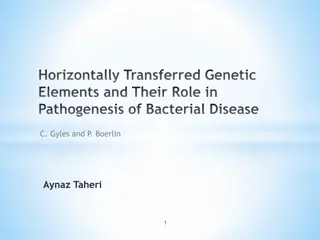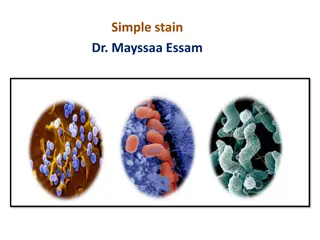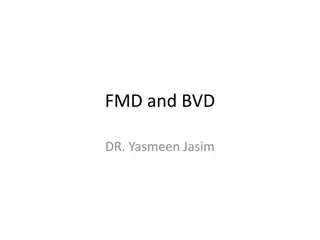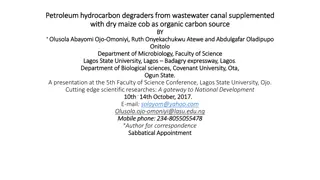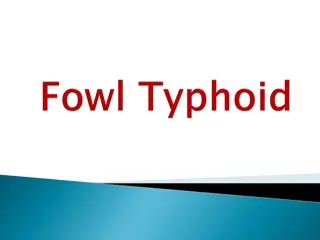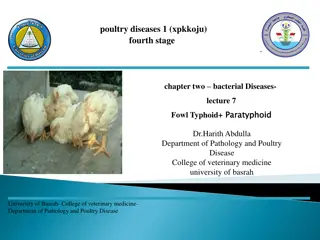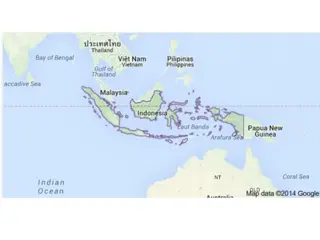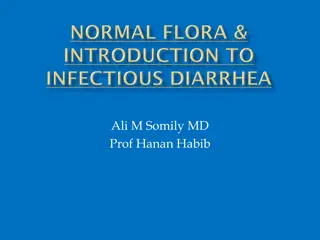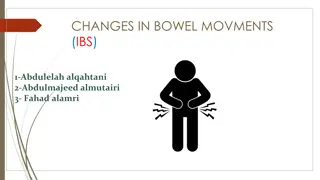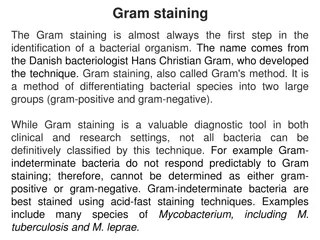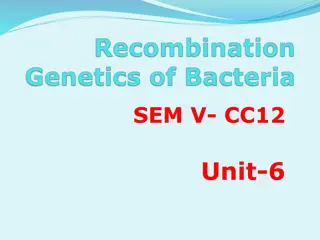Understanding Bacterial Toxins and Cell Damage
Bacterial toxins are poisonous substances produced by microbes that can cause harm to host cells through direct damage, toxin production, and hypersensitivity reactions. Toxigenesis is a crucial mechanism used by bacterial pathogens to induce disease, with endotoxins and exotoxins playing distinct r
2 views • 28 slides
Anaerobic Bacterial Infections: Overview and Clinical Implications
Anaerobic bacterial infections are caused by bacteria that do not require oxygen for growth, posing challenges in diagnosis and treatment. This article delves into the types of anaerobic bacteria, their role in human infections, and common clinical presentations such as abscess formation. Gram-negat
2 views • 24 slides
Understanding Bacterial Physiology and Growth
Bacterial physiology encompasses the growth, nutrition, and metabolism of bacteria. Bacterial growth involves binary fission, generation time, colony formation, and is influenced by various factors such as temperature, atmosphere, moisture, and radiation. Understanding the classification based on te
0 views • 33 slides
Exploring Bacterial Flagella: Structure and Function
Bacterial flagella are long, thin appendages crucial for motility in bacteria. Composed of filament, basal body, and hook, these structures play a vital role in bacterial movement. This article dives into the detailed structure and functionality of bacterial flagella, highlighting their importance i
0 views • 9 slides
Understanding Normal Flora of the Gastrointestinal Tract & Infectious Diarrhea
Normal flora in the gastrointestinal tract play a crucial role in maintaining health, but can also cause disease in certain conditions. This lecture covers the common flora in the GIT, their role in diseases, various types of acute diarrheal illnesses, epidemiology, and management of bacterial agent
1 views • 26 slides
Understanding Bacterial Locomotion: Flagellar Structure and Movement Mechanism
Bacterial locomotion involves intricate flagellar structures composed of filaments, basal bodies, and hooks. The synthesis of flagella is a complex process controlled by numerous genes. The rotation of the flagellar helix acts as a motor, determining the direction of bacterial movement.
1 views • 12 slides
Understanding Bacterial Photosynthesis: Types and Processes
Photosynthesis is the conversion of light energy into chemical energy, crucial for growth and production of ATP. Prokaryotes such as cyanobacteria, purple and green bacteria, and halobacteria demonstrate different forms of photosynthesis. Oxygenic photosynthesis, found in cyanobacteria, releases oxy
2 views • 20 slides
Introduction to Phage DNA Integration in Bacterial Cells
Phage DNA can be introduced into bacterial cells through two methods: transfection and in vitro packaging. Transfection involves mixing purified phage DNA with competent E. coli cells, inducing DNA uptake via heat shock. In vitro packaging utilizes proteins coded by the phage genome, which can be pr
1 views • 13 slides
Bacterial Culture Transfer Techniques and Growth Indicators
Bacterial cultures can be transferred using aseptic techniques to ensure purity. Growth indicators such as turbidity in liquid media and colonies on agar plates signify microbial growth. Proper sterilization and handling of instruments are crucial in the process. Techniques like streaking on agar pl
1 views • 4 slides
Overview of Viral Gastroenteritis: Etiology, Epidemiology, Clinical Features, Diagnosis, and Treatment
Viral gastroenteritis is an inflammation of the gastrointestinal tract primarily affecting the stomach and small intestine, leading to symptoms like acute diarrhea and vomiting. It can be caused by various infectious agents such as Rotavirus, Adenovirus, Caliciviruses, Astrovirus, Coronavirus, Torov
1 views • 7 slides
Understanding Johne's Disease in Ruminants: Causes, Transmission, and Clinical Findings
Johne's Disease, caused by Mycobacterium paratuberculosis, is a chronic bacterial infection affecting the lower intestinal tract of ruminants. It is characterized by chronic diarrhea and emaciation, mainly seen in mature animals. The mode of transmission includes contaminated food/water, intrauterin
0 views • 12 slides
Understanding Anti-Diarrheal Agents and Their Mechanisms
Diarrhea is a common gastrointestinal issue characterized by increased bowel movements and abdominal discomfort. This presentation delves into the causes and types of diarrhea, including acute and chronic forms. It also explores the various classes of anti-diarrheal medications and their mechanisms
0 views • 23 slides
Understanding Salmonellosis: Causes, Symptoms, and Prevention
Salmonellosis is a bacterial infection of the gastrointestinal tract caused by various serotypes of Salmonella bacteria. It affects both animals and humans, commonly spread through contaminated food sources. Symptoms in humans include diarrhea, abdominal cramps, and fever, with potential complicatio
0 views • 8 slides
Understanding Bacterial Spore Survival and Thermal Death Rates
Survival of bacterial spores during heat processing is crucial for food safety. The concept of Decimal Reduction Time (D value) and Thermal Death Time (TDT) curve help in understanding the thermal destruction of bacteria or spores. The Z value indicates the change in temperature necessary to cause a
6 views • 14 slides
Understanding Bovine Virus Diarrhea and Mucosal Disease in Cattle
Bovine Virus Diarrhea (BVD) and Mucosal Disease (MD) are two clinically distinct yet interconnected syndromes in cattle caused by Pestivirus. While originally thought to be separate, they share a common viral etiology. BVD can lead to persistent infections, while MD is sporadic, progressive, and fat
0 views • 14 slides
Understanding Bacterial Endospores and Sporulation Process
Bacterial endospores are dormant structures that allow bacteria to survive harsh conditions. They contain vital genetic material and are resistant to drought, heat, radiation, and chemicals. The process of sporulation involves the formation of endospores within bacterial cells, followed by germinati
0 views • 34 slides
Understanding Viral Gastroenteritis: Causes, Symptoms, and Transmission
Viral gastroenteritis, commonly known as viral diarrhea, is a prevalent infection affecting mainly infants and young children. The disease is self-limiting, with symptoms like diarrhea, vomiting, and abdominal pain. Key viral etiologies include Rota viruses, Astroviruses, Norovirus, and Enteric aden
0 views • 19 slides
Understanding the Normal Flora of the Gastrointestinal Tract and Infectious Diarrhea
Explore the common normal flora of the gastrointestinal tract (GIT) and how they play a role in health and disease, specifically focusing on infectious diarrhea. Learn about different types of acute diarrheal illnesses, epidemiology, host defenses against GI infections, and the pathogenesis of bacte
0 views • 38 slides
Understanding Diarrhea: Causes, Classification, and Significance
This informative content delves into the physiology of fluid in the small intestine, defines diarrhea, and outlines its various types and common causes. It emphasizes the importance of addressing diarrhea promptly to prevent dehydration and electrolyte imbalances, especially in children, as it remai
2 views • 52 slides
Understanding Bacterial Taxonomy and Staining Techniques
Bacterial taxonomy involves classifying and identifying bacteria, while staining techniques such as Gram staining help differentiate between Gram-positive and Gram-negative bacteria. This article discusses the importance of distinguishing bacterial strains, preparing smears, and performing different
0 views • 17 slides
Understanding Feco-Oral Diseases and Diarrhea Transmission
Feco-oral diseases, primarily transmitted through the fecal-oral route, remain a significant global health concern, especially affecting children under 5 and the elderly. Diarrhea, characterized by WHO as three or more watery stools in 24 hours, poses a substantial burden, with infectious agents cau
0 views • 46 slides
Understanding Chronic Diarrhea: Causes and Consequences
Chronic diarrhea is characterized by persistent loose, watery stools lasting more than 14 days. The condition can be caused by various factors such as osmotic, secretory, inflammatory, or motility disorders. In developing countries, it often follows acute infections, while in developed countries, un
0 views • 71 slides
Understanding Diarrhea: Causes, Symptoms, and Pathophysiology
Diarrhea is a common symptom that can be caused by various factors such as viral, bacterial, parasitic infections, dietary changes, drugs, systemic diseases, and intestinal obstructions. It can lead to dehydration and other serious complications if not treated promptly. The pathophysiology of diarrh
0 views • 15 slides
Understanding Bacterial Growth and Reproduction in Microbiology
Bacterial growth involves binary fission where cells divide into two, leading to the formation of new cells. The generation time varies among species. The growth curve consists of lag, exponential, stationary, and death phases, each with distinct characteristics. By understanding these phases, resea
0 views • 15 slides
Understanding Bacterial Flagella: Structure and Function
Bacterial flagella, known as flagellum, are hairlike appendages responsible for swimming motility. They are composed of three parts - the filament, basal body, and hook. The filament is a hollow cylinder made of flagellin protein subunits. The synthesis of flagella involves multiple genes. This arti
0 views • 6 slides
Understanding Bacterial Colony Morphology for Microbiology Analysis
Bacterial colonial morphology plays a crucial role in identifying bacteria and fungi. This exercise focuses on recognizing the cultural characteristics of bacteria on agar plates through colony morphology. Each colony represents a genetically similar group of microorganisms derived from a single cel
0 views • 6 slides
Mechanisms and Role of Horizontally Transferred Genetic Elements in Bacterial Disease Pathogenesis
This presentation explores the transfer of foreign DNA into bacteria, discussing mechanisms such as conjugation, transduction, and transformation. It delves into the significance of Mobile Genetic Elements (MGEs) like plasmids, bacteriophages, and transposons in bacterial virulence and pathogenesis.
0 views • 20 slides
Understanding Bacterial Morphology and Simple Stain Techniques
Explore the characteristics of bacteria based on their shape and structure, grouped into spherical, rod-shaped, and helical types. Learn about bacterial smear preparation principles and the simple stain procedure for observing bacterial cells under a microscope. Discover various bacterial species an
0 views • 13 slides
Understanding Foot-and-Mouth Disease (FMD) and Bovine Viral Diarrhea (BVD)
Foot-and-mouth disease (FMD) is a highly contagious animal disease affecting cloven-hoofed animals, while Bovine Viral Diarrhea (BVD) is a serious cattle disease caused by the BVD virus. FMD is not transmissible to humans and is caused by different strains of Aphthovirus. Symptoms of FMD include ves
0 views • 12 slides
Evaluation of Petroleum Hydrocarbon Degraders in Wastewater Canal Supplemented with Organic Carbon Source
This study explores the potential of native bacterial populations in wastewater for bioremediation of petroleum hydrocarbon-polluted environments. The research involved exposing Bonny light crude oil to wastewater canal samples supplemented with dry maize cob as an organic carbon source. Results sho
0 views • 26 slides
Understanding Fowl Typhoid in Domestic Birds
Fowl Typhoid is a septicemic disease affecting domestic birds, characterized by acute and chronic phases, enlarged spleen, bronzy colored liver, and diarrhea. It is caused by Salmonella gallinarum and primarily affects young and adult chickens. The disease has a short incubation period of 4-5 days,
0 views • 7 slides
Understanding Fowl Typhoid and Paratyphoid in Poultry
Fowl typhoid is a septicemic disease affecting domestic birds, characterized by acute and chronic phases, enlarged spleen, bronzy-colored liver, and diarrhea. It is caused by Salmonella gallinarum and is very lethal, with mortality reaching 75% in untreated flocks. The disease shares similarities wi
0 views • 15 slides
Overview of Bovine Viral Diarrhea Virus (BVDV)
Bovine Viral Diarrhea Virus (BVDV) is an RNA virus belonging to the Pestivirus genus in the Flaviviridae family. It is classified into BVDV-1 and BVDV-2 genotypes with distinct biotypes. BVDV is a significant infectious disease in the livestock industry worldwide, with high prevalence and clinical c
0 views • 14 slides
Understanding and Managing Gastrointestinal Issues When Traveling
Explore insights on gastrointestinal concerns while traveling, including Delhi Belly, acute and chronic diarrhea, bacterial infections, prevention strategies, and treatment options like ORS, probiotics, and vaccines.
0 views • 11 slides
Study on Using MLIL Model to Replace RIL for Studying Bacterial Diarrhea
Shigellosis, a diarrheal disease prevalent in developing countries, lacks an effective vaccine. This study aims to assess the protective capability of S. dysenteriae sub-unit pili proteins using the MLIL method. Mice were immunized with different protein variants, and the results indicate potential
0 views • 16 slides
Understanding Acute Diarrheal Illness and Gastrointestinal Infections
Acute diarrheal illness is a common issue globally, leading to significant morbidity and mortality. This lecture covers the types of acute diarrhea, host defenses, pathogens like E. coli, Campylobacter, and Yersinia, and their management. It also discusses microbiological diagnosis methods, food poi
0 views • 30 slides
Understanding Irritable Bowel Syndrome: Symptoms, Diagnosis, and Management
Define constipation and diarrhea, discuss the definition, etiology, and classification of IBS, explain how to diagnose IBS, list alarm symptoms and differential diagnosis, provide a management plan and follow-up, and recognize when to refer to a specialist. People with irritable bowel syndrome may s
0 views • 35 slides
Understanding Gram Staining in Bacterial Identification
Gram staining is a crucial technique in identifying bacterial organisms, developed by Hans Christian Gram. It involves differentiating bacteria into gram-positive and gram-negative groups based on cell wall properties. Gram staining has five basic steps and helps in determining bacterial characteris
0 views • 15 slides
Bacterial Conjugation: Mechanism and Applications
Bacterial conjugation is the process of transferring genetic material between bacterial cells through direct contact or bridge-like connections. Discovered in 1946, this mechanism enables the transfer of DNA regions between various bacterial species, including Gram-negative and Gram-positive bacteri
0 views • 58 slides
Bacterial Cell Shapes and Simple Stain Procedure
Explore the three basic shapes of bacterial cells - Coccus, Bacillus, and Spiral - and learn about different arrangements within each shape. Dive into the Simple Stain procedure, a straightforward staining technique using single stains like methylene blue and crystal violet, to prepare and visualize
0 views • 32 slides




